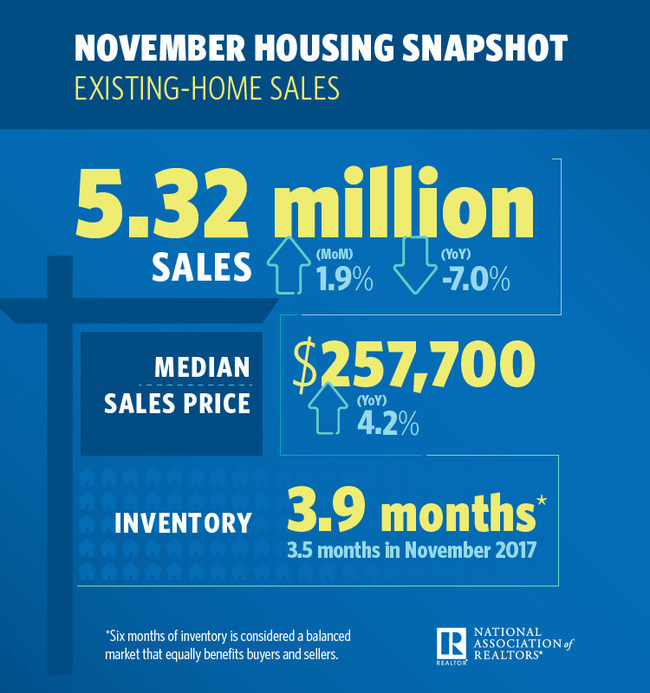WASHINGTON, Dec. 19, 2018 /PRNewswire/ — Existing-home sales increased in November, according to the National Association of Realtors®, marking two consecutive months of increases. Three of four major U.S. regions saw gains in sales activity last month.
Total existing-home sales1, https://www.nar.realtor/existing-home-sales, completed transactions that include single-family homes, townhomes, condominiums and co-ops, increased 1.9 percent from October to a seasonally adjusted rate of 5.32 million in November. Sales are now down 7.0 percent from a year ago (5.72 million in November 2017).


Lawrence Yun, NAR’s chief economist, says two consecutive months of increases is a welcomed sign for the market. “The market conditions in November were mixed, with good signs of stabilizing home sales compared to recent months, though down significantly from one year ago. Rising inventory is clearly taming home price appreciation.”
The median existing-home price2 for all housing types in November was $257,700, up 4.2 percent from November 2017 ($247,200). November’s price increase marks the 81st straight month of year-over-year gains.
Total housing inventory3 at the end of November decreased to 1.74 million, down from 1.85 million existing homes available for sale in October. This represents an increase from 1.67 million a year ago, however. Unsold inventory is at a 3.9-month supply at the current sales pace, down from 4.3 last month and up from 3.5 months a year ago.
“A marked shift is occurring in the West region, with much lower sales and very soft price growth,” says Yun. “It is also the West region where consumers have expressed the weakest sentiment about home buying, largely due to lack of affordable housing inventory.”
Properties typically stayed on the market for 42 days in November, up from 36 days in October and 40 days a year ago. Forty-three percent of homes sold in November were on the market for less than a month.
“It is not surprising to see homes remain on the market a little longer,” said NAR President John Smaby, a second-generation Realtor® from Edina, Minnesota and broker at Edina Realty. “Buyers can often negotiate a more favorable price in those circumstances, especially when paired with a motivated seller and the aid of a Realtor® familiar with their local market.”
Realtor.com®‘s Market Hotness Index, measuring time-on-the-market data and listing views per property, revealed that the hottest metro areas in November were Midland, Texas; Fort Wayne, Ind.; Columbus, Ohio; Odessa, Texas; and Boston–Cambridge–Newton, Mass.
According to Freddie Mac, the average commitment rate for a 30-year, conventional, fixed-rate mortgage increased to 4.87 percent in November from 4.83 percent in October. The average commitment rate for all of 2017 was 3.99 percent.
First-time buyers were responsible for 33 percent of sales in November, up from last month and a year ago (31 percent and 29 percent, respectively). NAR’s 2018 Profile of Home Buyers and Sellers – released in late 20184 – revealed that the annual share of first-time buyers was 33 percent.
“Inventory is plentiful on the upper-end, but a mismatch between supply and demand exists at affordable price points,” Yun added. “Therefore, facilitating real estate development of affordable housing units in designated Opportunity Zones can provide better housing access in addition to boosting the local economy.”
Distressed sales5 – foreclosures and short sales – represented 2 percent of sales in November (the lowest since NAR began tracking in October 2008), down from 3 percent last month and down from 4 percent a year ago.
All-cash sales accounted for 21 percent of transactions in November, down from October and a year ago (23 and 22 percent, respectively). Individual investors, who account for many cash sales, purchased 13 percent of homes in November, down from October and a year ago (15 percent and 14 percent, respectively).
Single-family and Condo/Co-op Sales
Single-family home sales sit at a seasonally adjusted annual rate of 4.71 million in November. That is up from 4.62 million in October, but 6.7 percent below the 5.05 million sales pace from a year ago. The median existing single-family home price was $260,500 in November, up 5.0 percent from November 2017.
Existing condominium and co-op sales were recorded at a seasonally adjusted annual rate of 610,000 units in November, up 1.7 percent from last month but down 9.0 percent from a year ago. The median existing condo price was $236,400 in November, which is down 1.3 percent from a year ago.
Regional Breakdown
November existing-home sales in the Northeast increased 7.2 percent to an annual rate of 740,000, 2.6 percent below a year ago. The median price in the Northeast was $291,400, which is up 6.5 percent from November 2017.
In the Midwest, existing-home sales rose 5.5 percent from last month to an annual rate of 1.34 million in November, down 4.3 percent from a year ago. The median price in the Midwest was $199,100, up 2.6 percent from last year.
Existing-home sales in the South grew 2.3 percent to an annual rate of 2.20 million in November, down 5.6 percent from last year. The median price in the South was $223,600, up 3.2 percent from a year ago.
Existing-home sales in the West declined 6.3 percent to an annual rate of 1.04 million in November, 15.4 percent below a year ago. The median price in the West was $380,600 up 1.8 percent from November 2017.
The National Association of Realtors® is America’s largest trade association, representing 1.3 million members involved in all aspects of the residential and commercial real estate industries.
NOTE: For local information, please contact the local association of Realtors® for data from local multiple listing services. Local MLS data is the most accurate source of sales and price information in specific areas, although there may be differences in reporting methodology.
1Existing-home sales, which include single-family, townhomes, condominiums and co-ops, are based on transaction closings from Multiple Listing Services. Changes in sales trends outside of MLSs are not captured in the monthly series. NAR rebenchmarks home sales periodically using other sources to assess overall home sales trends, including sales not reported by MLSs.
Existing-home sales, based on closings, differ from the U.S. Census Bureau’s series on new single-family home sales, which are based on contracts or the acceptance of a deposit. Because of these differences, it is not uncommon for each series to move in different directions in the same month. In addition, existing-home sales, which account for more than 90 percent of total home sales, are based on a much larger data sample – about 40 percent of multiple listing service data each month – and typically are not subject to large prior-month revisions.
The annual rate for a particular month represents what the total number of actual sales for a year would be if the relative pace for that month were maintained for 12 consecutive months. Seasonally adjusted annual rates are used in reporting monthly data to factor out seasonal variations in resale activity. For example, home sales volume is normally higher in the summer than in the winter, primarily because of differences in the weather and family buying patterns. However, seasonal factors cannot compensate for abnormal weather patterns.
Single-family data collection began monthly in 1968, while condo data collection began quarterly in 1981; the series were combined in 1999 when monthly collection of condo data began. Prior to this period, single-family homes accounted for more than nine out of 10 purchases. Historic comparisons for total home sales prior to 1999 are based on monthly single-family sales, combined with the corresponding quarterly sales rate for condos.
2The median price is where half sold for more and half sold for less; medians are more typical of market conditions than average prices, which are skewed higher by a relatively small share of upper-end transactions. The only valid comparisons for median prices are with the same period a year earlier due to seasonality in buying patterns. Month-to-month comparisons do not compensate for seasonal changes, especially for the timing of family buying patterns. Changes in the composition of sales can distort median price data. Year-ago median and mean prices sometimes are revised in an automated process if additional data is received.
The national median condo/co-op price often is higher than the median single-family home price because condos are concentrated in higher-cost housing markets. However, in a given area, single-family homes typically sell for more than condos as seen in NAR’s quarterly metro area price reports.
3Total inventory and month’s supply data are available back through 1999, while single-family inventory and month’s supply are available back to 1982 (prior to 1999, single-family sales accounted for more than 90 percent of transactions and condos were measured only on a quarterly basis).
4Survey results represent owner-occupants and differ from separately reported monthly findings from NAR’s Realtors®Confidence Index, which include all types of buyers. Investors are under-represented in the annual study because survey questionnaires are mailed to the addresses of the property purchased and generally are not returned by absentee owners. Results include both new and existing homes.
5Distressed sales (foreclosures and short sales), days on market, first-time buyers, all-cash transactions and investors are from a monthly survey for the NAR’s Realtors® Confidence Index, posted at nar.realtor.
NOTE: NAR’s Pending Home Sales Index for November is scheduled for release on December 28, and Existing-Home Sales for December will be released January 22; release times are 10:00 a.m. ET.
Information about NAR is available at www.nar.realtor. This and other news releases are posted in the newsroom under the “About NAR” tab. Statistical data in this release, as well as other tables and surveys, are posted in the “Research and Statistics” tab.
SOURCE National Association of Realtors